Managing Assets
Use the Asset Management APIs to attach various types of Assets to a Stream. You have the option to use existing Assets or create new ones to add to a Stream.
The following assets are supported:
-
Fabric Cloud Router (FCR) - To retrieve the details of an existing Cloud Router, send a
GETrequest to the/fabric/v4/routers/{routerId}endpoint. To create a new Fabric Cloud Router, send aPOSTrequest to the/fabric/v4/routersendpoint. -
Connections - To retrieve the details of an existing connection, send a
GETto the/fabric/v4/connections/{connectionId}endpoint. To create a new connection, send aPOSTrequest to the/fabric/v4/connectionsendpoint. -
Ports - To retrieve a list of all your ports, send a
GETrequest to the/fabric/v4/portsendpoint. To create a new port, Send aPOSTrequest to the/fabric/v4/portsendpoint. -
Metros - To view available metros, send a
GETrequest to the/fabric/v4/metrosendpoint. -
Projects - To view all of your project's events, including events for Network Edge devices and all other assets in your project, attach a project to your stream. To get a list of your projects, send a
GETrequest to the/resourceManager/v2/projectsendpoint. -
Organizations - To view organization events, such as role assignments, attach an organization to your stream. To get information about your organizations, refer to the Managing Organizations page.
Prerequisites
-
To attach assets (Port, Connections, etc) onto a stream, the user needs to have at least the
ViewerRole on that asset. -
To attach projects to a stream for lifecycle provisioning events, the user needs to have the
Project Adminrole. -
To attach organizations to a stream for role assignment, user login, and resource management events, the user needs to have the
Org Adminrole. To attach organizations to a stream for role assignment, the user needs to have theOrg Adminrole. -
If you are using the API, submit your user credentials, Client ID, and Client Secret for OAuth2 authentication. Refer to API Authentication for more information on how to authenticate your requests to the Equinix API.
Attaching Assets in the Portal
-
Log in to the Customer Portal > Fabric Dashboard.
-
From the Observability menu, select Data Streams.

-
Click the Stream Name you want to add resources to.
-
From the Actions drop-down menu, select Add Resources.
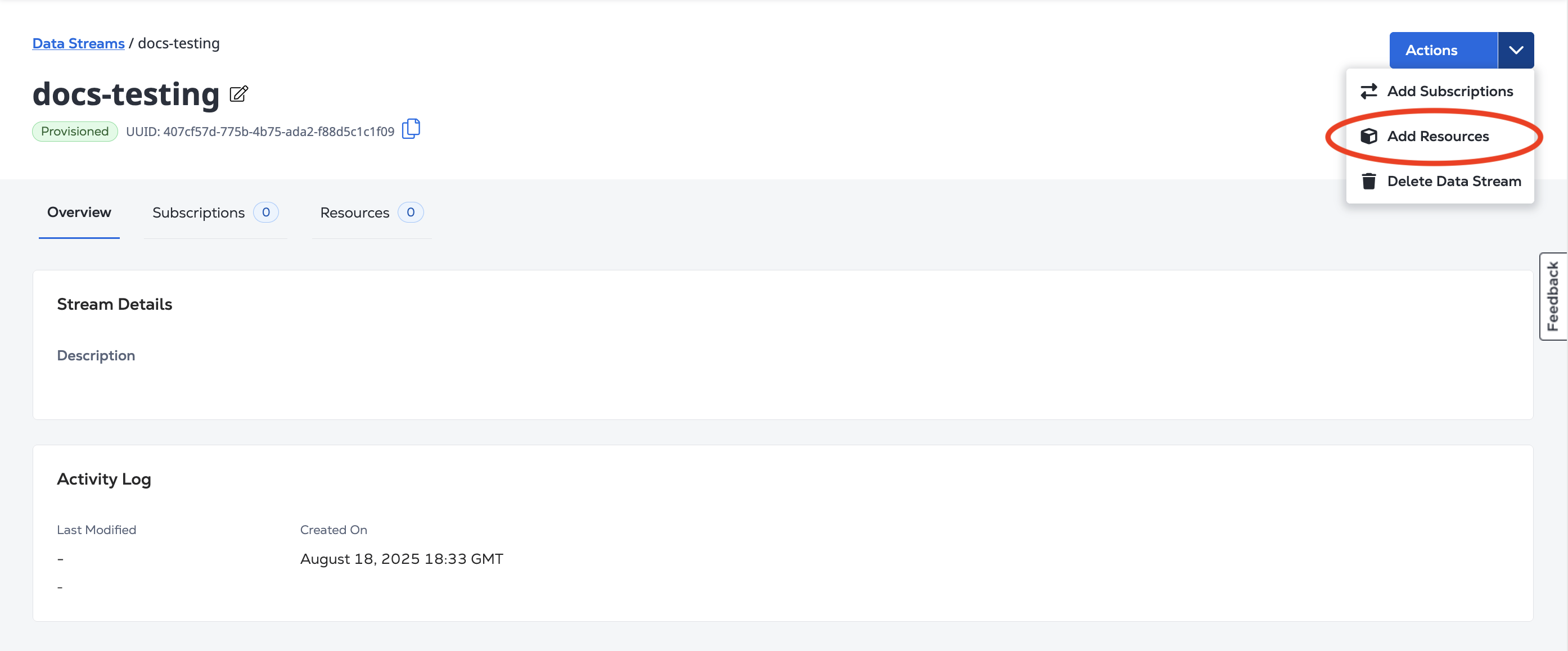
-
Use the File Directory menu to filter the available resource types.
-
Select the specific resource or resources to add to the Stream. Added resources send event data and if you want to also send metrics, toggle Enable Metrics. Once you have selected your desired resources, click Review.
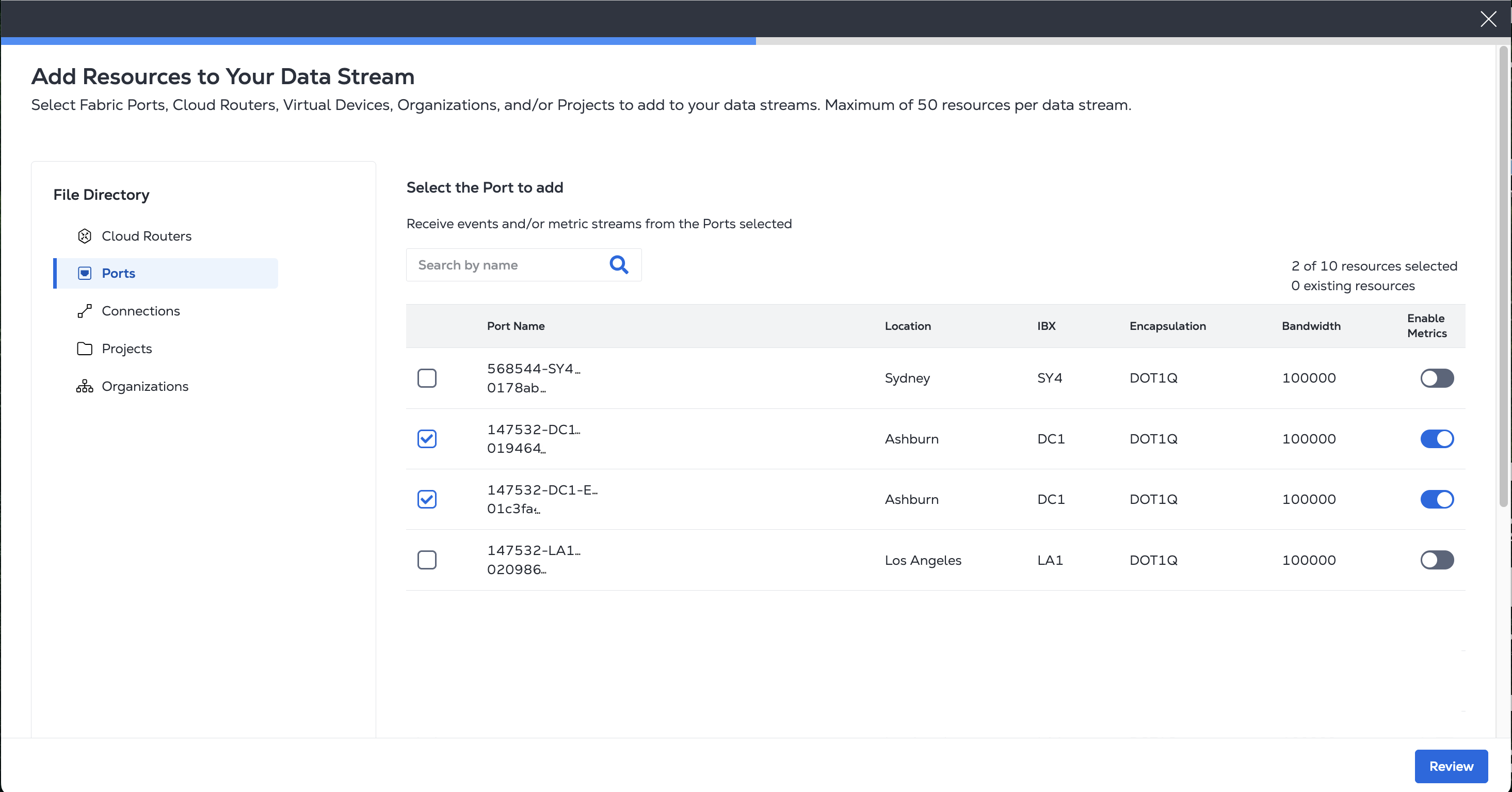
-
Review the list of assets to attach to the stream.
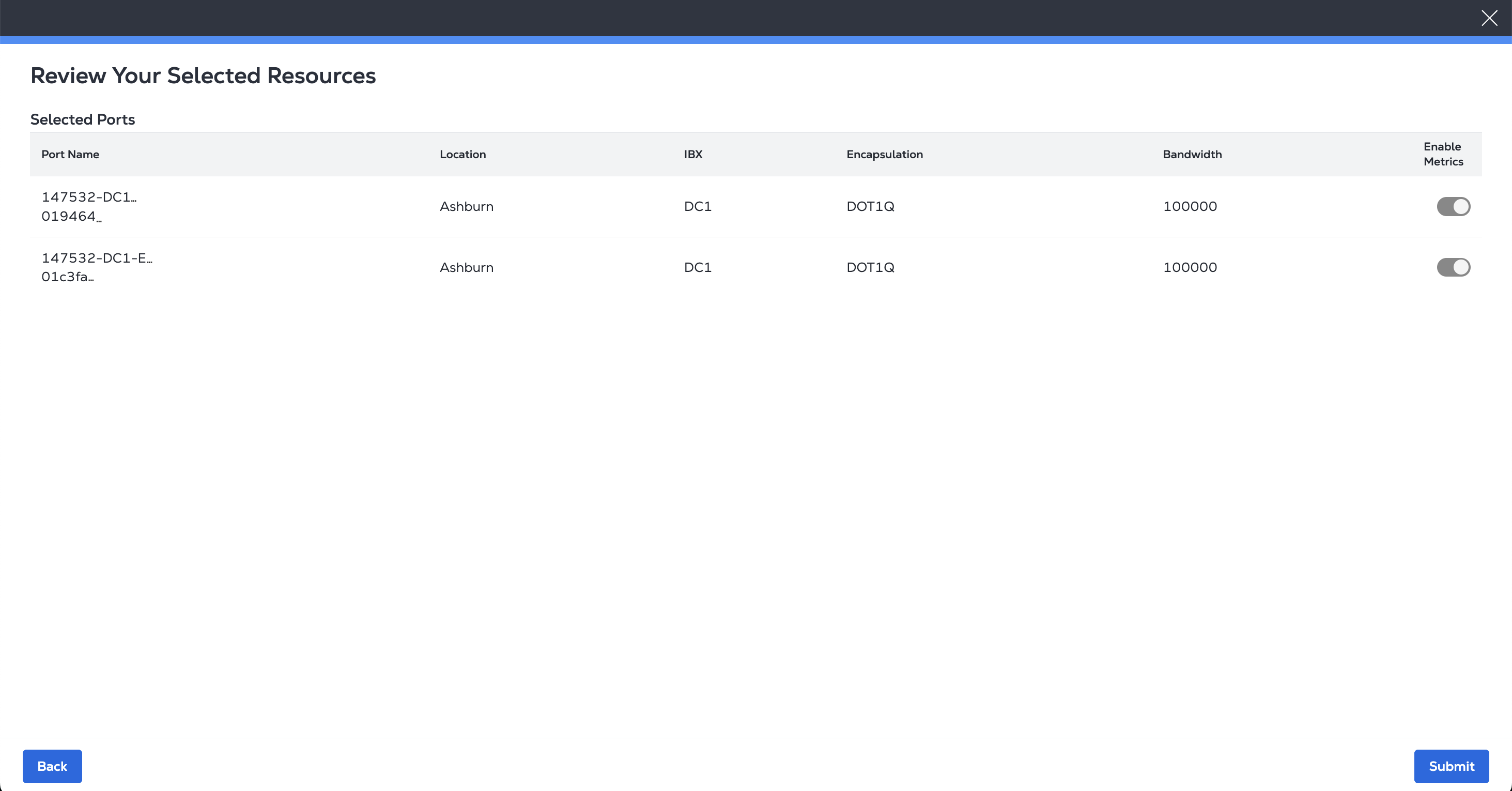
-
Click Submit.
Attaching Assets in the API
To attach a port to a stream, send a PUT request to the /fabric/v4/streams/{streamId}/{asset}/{assetId} endpoint.
Refer to the examples below to attach an asset to a stream for the supported assets.
Ports
Sample cURL Request:
curl -X 'PUT' 'https://api.equinix.com/fabric/v4/streams/<streamId>/ports/<portId>' \
-H 'accept: application/json' \
-H 'Content-Type: application/json' \
-H 'Authorization: Bearer <Bearer Token>' \
-d '{
"metricsEnabled": true
}'
Sample Response:
{
"href": "https://api.equinix.com/fabric/v4/streams/241372e9-79c9-4ef8-b77a-8b8176c2098b4/ports/dee885d7-a845-4873-8774-f83012e7a",
"uuid": "dee885d7-a845-4873-8774-f83012e7a",
"type": "XF_PORT",
"metricsEnabled": true,
"attachmentStatus": "ATTACHING"
}
Connections
Sample cURL Request:
curl -X 'PUT' 'https://api.equinix.com/fabric/v4/streams/<streamId>/connections/<connectionId>' \
-H 'accept: application/json' \
-H 'Content-Type: application/json' \
-H 'Authorization: Bearer <Bearer Token>' \
-d '{
"metricsEnabled": true
}'
Sample Response:
{
"href": "https://api.equinix.com/fabric/v4/streams/241372e9-79c9-4ef8-b77a-8b8176c2098b4/connections/dee885d7-a845-4873-8774-f83012e7a",
"uuid": "dee885d7-a845-4873-8774-f83012e7a",
"type": "IP_VC",
"metricsEnabled": true,
"attachmentStatus": "ATTACHING"
}
Fabric Cloud Routers
Sample cURL Request:
curl -X 'PUT' 'https://api.equinix.com/fabric/v4/streams/<streamId>/routers/<routerId>' \
-H 'accept: application/json' \
-H 'Content-Type: application/json' \
-H 'Authorization: Bearer <Bearer Token>' \
-d '{
"metricsEnabled": false
}'
Sample Response:
{
"href": "https://api.equinix.com/fabric/v4/streams/241372e9-79c9-4ef8-b77a-8b8176c2098b4/routers/dee885d7-a845-4873-8774-f83012e7a",
"uuid": "dee885d7-a845-4873-8774-f83012e7a",
"type": "XF_ROUTER",
"metricsEnabled": false,
"attachmentStatus": "ATTACHED"
}
Metros
Sample cURL Request:
curl -X 'PUT' 'https://api.equinix.com/fabric/v4/streams/<streamId>/metros/<metroCode>' \
-H 'accept: application/json' \
-H 'Content-Type: application/json' \
-H 'Authorization: Bearer <Bearer Token>' \
-d '{
"metricsEnabled": true
}'
Sample Response:
{
"href": "https://api.equinix.com/fabric/v4/streams/241372e9-79c9-4ef8-b77a-8b8176c2098b4/metros/SV",
"uuid": "SV",
"type": "XF_METRO",
"metricsEnabled": true,
"attachmentStatus": "ATTACHED"
}
Projects
Sample cURL Request:
curl -X 'PUT' 'https://api.equinix.com/fabric/v4/streams/<streamId>/projects/<projectId>' \
-H 'accept: application/json' \
-H 'Content-Type: application/json' \
-H 'Authorization: Bearer <Bearer Token>' \
-d '{
"includes": ["*"],
"metricsEnabled": true
}'
Sample Response:
{
"href": "https://api.equinix.com/fabric/v4/streams/241372e9-79c9-4ef8-b77a-8b8176c2098b4/projects/dee885d7-a845-4873-8774-f83012e7a",
"uuid": "dee885d7-a845-4873-8774-f83012e7a",
"type": "PROJECT",
"metricsEnabled": true ,
"attachmentStatus": "ATTACHED"
}
Projects: Search Network Edge Device Events
Sample cURL Request:
curl -X GET 'https://api.equinix.com/fabric/v4/cloudevents/search'
-H 'Content-Type: application/json' \
-H 'Authorization: Bearer ' \
-d '{
"filter": {
"and": [
{
"property": "/type",
"operator": "IN",
"values": [
"equinix.network_edge.device.*"
]
},
{
"property": "/subject",
"operator": "IN",
"values": [
"/ne/v1/devices/903bb0ad-65cd-422c-94d3-a506cce0a36a*"
]
},
{
"property": "/time",
"operator": "BETWEEN",
"values": [
"2025-08-15T17:31:00.000Z",
"2025-08-25T17:31:00.000Z"
]
}
]
},
"pagination": {
"offset": 0,
"limit": 20
}
}'
Sample Response:
{
"pagination": {
"offset": 0,
"limit": 20,
"total": 2
},
"data": [
{
"specversion": "1.0",
"source": "https://api.equinix.com/fabric/v4/cloudevents",
"id": "54ebab18-5e38-46bf-af00-cdbd0bbf7207",
"time": "2025-08-27T20:18:47.300Z",
"type": "equinix.network_edge.device.attribute.changed",
"subject": "/ne/v1/devices/903bb0ad-65cd-422c-94d3-a506cce0a36a",
"datacontenttype": "application/json",
"severitynumber": "9",
"severitytext": "INFO",
"equinixproject": "4565754-1e33-4dfd-b7c8-0383259cf754",
"authtype": "user",
"authid": "132343",
"data": {
"message": "Device Name changed to New-device",
"resource": {
"name": "Network-edge device",
"status": "PROVISIONED",
"uuid": "df23bb0ad-65cd-422c-94d3-a506cce0a36a",
"type": "DEVICE"
},
"authcontext": {
"type": "user",
"id": "132343",
"name": "Test User",
"email": "user@test.com"
}
}
},
{
"specversion": "1.0",
"source": "https://api.equinix.com/fabric/v4/cloudevents",
"id": "71ab91ec-ef19-4def-85f3-1fcac99681c4",
"time": "2025-08-14T19:12:04.726Z",
"type": "equinix.network_edge.device.state.provisioned",
"subject": "/ne/v1/devices/903bb0ad-65cd-422c-94d3-a506cce0a36a",
"datacontenttype": "application/json",
"severitynumber": "9",
"severitytext": "INFO",
"equinixproject": "4565754-1e33-4dfd-b7c8-0383259cf754",
"authtype": "system",
"authid": "equinix",
"data": {
"message": "Device status changed",
"resource": {
"name": "Network-edge device",
"status": "PROVISIONED",
"uuid": "903bb0ad-65cd-422c-94d3-a506cce0a36a",
"type": "DEVICE"
},
"authcontext": {
"type": "user",
"id": "132343",
"name": "Test User",
"email": "user@test.com"
}
}
}
]
}
Organizations
Sample cURL Request:
curl -X 'PUT' 'https://api.equinix.com/fabric/v4/streams/<streamId>/organizations/<organizationId>' \
-H 'accept: application/json' \
-H 'Content-Type: application/json' \
-H 'Authorization: Bearer <Bearer Token>' \
-d '{
"includes": ["*"],
"metricsEnabled": true
}'
Sample Response:
{
"href": "https://api.equinix.com/fabric/v4/streams/241372e9-79c9-4ef8-b77a-8b8176c2098b4/organizations/dee885d7-a845-4873-8774-f83012e7a",
"uuid": "dee885d7-a845-4873-8774-f83012e7a",
"type": "ORGANIZATION",
"metricsEnabled": true,
"attachmentStatus": "ATTACHED"
}
Viewing Attached Assets
- Portal
- API
To view the list of resources that you have added to a stream, select its stream from your Data Streams Inventory.
From the Stream Details page, click Resources to view the Resource List.
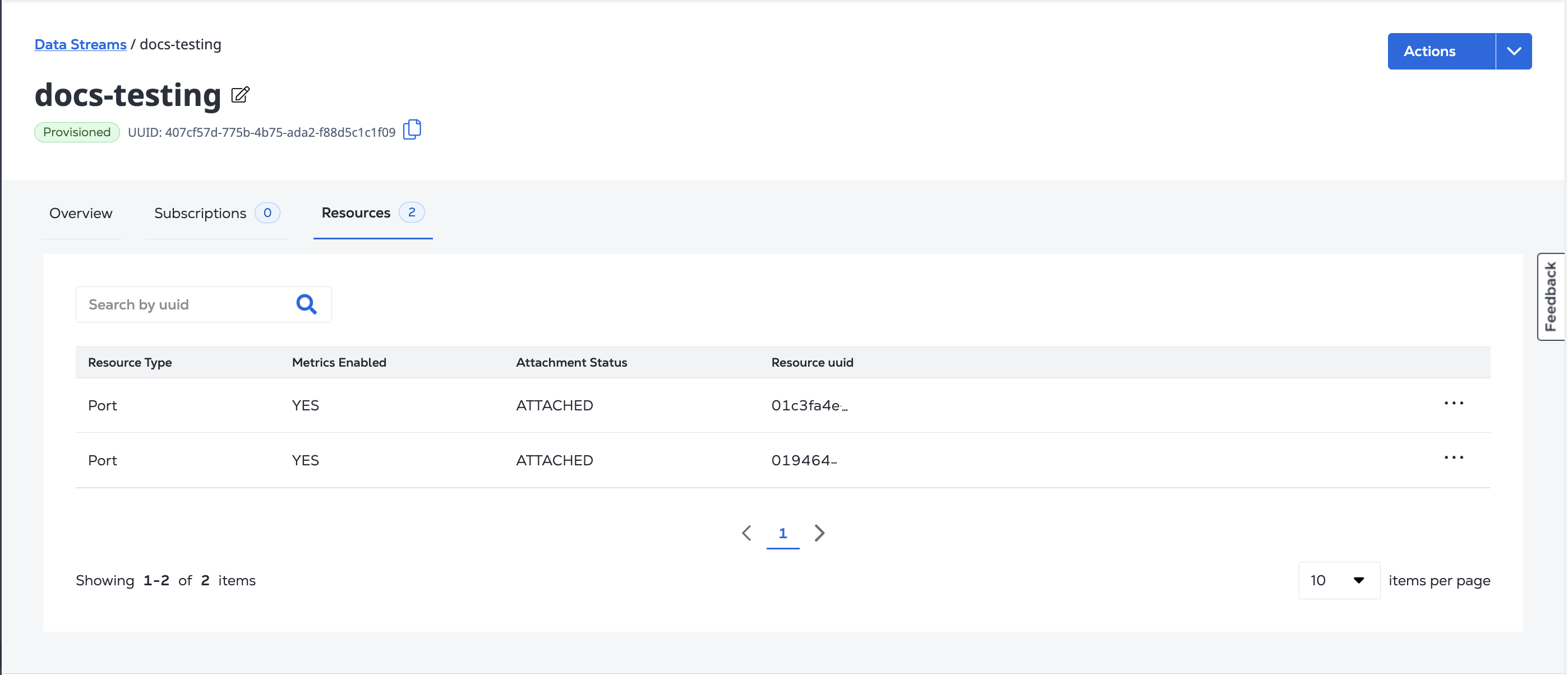
To get an asset's attachment details and status, send a GET request to the fabric/v4/streams/{streamId}/{asset}/{assetId} endpoint.
Sample cURL Request:
curl -X 'GET' 'https://api.equinix.com/fabric/v4/streams/657400f8-d360-11e9-bb65-2a2ae2dbcce5/ports/757400f8-d360-11e9-bb65-2a2ae2dbcce6' \
-H 'accept: application/json' \
-H 'Authorization: Bearer <Bearer Token>'
Sample Response:
{
"href": "https://api.equinix.com/fabric/v4/stream/241372e9-79c9-4ef8-b77a-8b8176c2098b4/ports/dee885d7-a845-4873-8774-f83012e7a",
"uuid": "dee885d7-a845-4873-8774-f83012e7a",
"metricsEnabled": true,
"attachmentStatus": "ATTACHED"
}
Deleting an Asset Attachment
- Portal
- API
To delete a resource from a stream, select the stream from your Data Streams Inventory. From the Stream Details page, click Resources to view the Resource List.
From the resource's options menu, click Delete Resource.
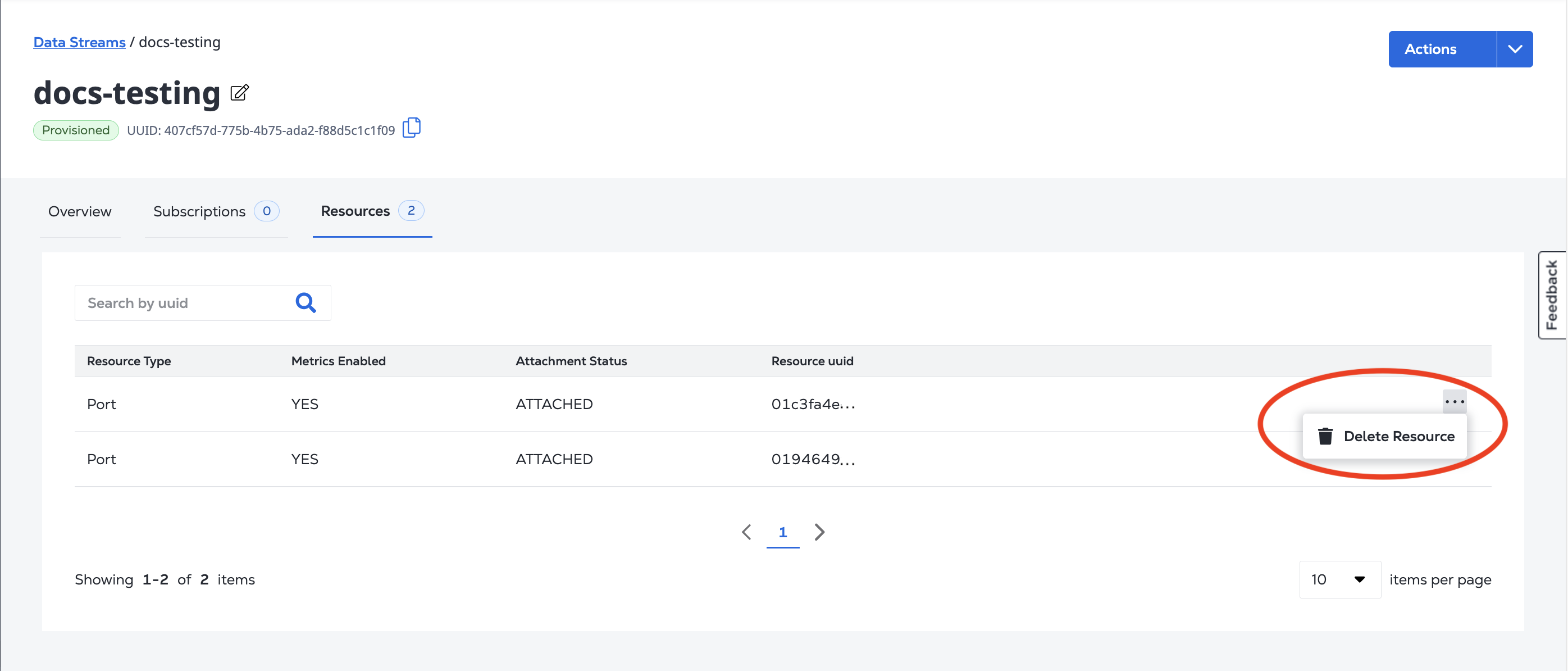
To delete an asset attachment, send a DELETE request to the fabric/v4/streams/{streamId}/{asset}/{assetId} endpoint.
Sample cURL Request:
curl -X 'DELETE' 'https://api.equinix.com/fabric/v4/streams/657400f8-d360-11e9-bb65-2a2ae2dbcce5/ports/757400f8-d360-11e9-bb65-2a2ae2dbcce6' \
-H 'Content-Type: application/json' \
-H 'Authorization: Bearer <Bearer Token>'
Sample Response:
{
"href": "https://api.equinix.com/fabric/v4/stream/241372e9-79c9-4ef8-b77a-8b8176c2098b4/ports/dee885d7-a845-4873-8774-f83012e7a",
"uuid": "dee885d7-a845-4873-8774-f83012e7a",
"metricsEnabled": true,
"attachmentStatus": "DETACHING"
}